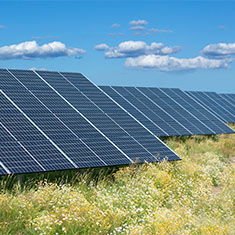
By Sara Weaver, CWB, PhD, Principal and Natural Resources Director for Bowman
When it comes to solar power, there’s little question that producing clean energy benefits the environment. A rarely talked about consequence of the solar parks, however, is the adverse effects they can have on ecosystems if not developed responsibly.
Solar parks take up a vast amount of land and more will be needed to meet sustainability goals. According to a study from the United States Department of Energy, more than 10 million acres of land would be needed for utility scale solar energy development to generate over one terawatt of solar electricity to meet decarbonization goals for the United States electricity grid.
Oftentimes, existing vegetation is destroyed during development of solar parks, and is replaced with non-native low-growing grasses that displace native pollinator ecosystems which are experiencing population declines. The United Nations reports that close to 35% of invertebrate pollinators, particularly bees and butterflies, and about 17% of vertebrate pollinators, such as bats, face extinction globally. A recent study from the United States Department of Agriculture found some bee populations have fallen by more than 80% from 2007-2022.
This is a huge concern, both in terms of conservation and overall human survival. Pollinators are an essential part of food production, with 75% of global crops at least partially dependent on pollination, according to the United Nations Food and Agriculture Organization. While many staple items, like wheat, rice and legumes, are not pollinator-reliant, micronutrient-rich foods like berries, melons, apples, avocadoes, coffee beans, nuts and oilseed are pollinator-dependent, as well as cucurbit vegetables, like cucumbers, squash and zucchini.
Without pollinators, we risk increasing starvation. According to the Harvard T.H. Chan School of Public Health, inadequate pollination has led to a 3-5% loss of fruit, vegetable and nut production and an estimated 427,000 excess deaths annually from loss of healthy food consumption. No amount of clean energy is relevant or useful if we can’t eat.
Luckily, we don’t have to choose. Growing pollinator habitats within and surrounding solar parks creates an opportunity for a synergistic partnership that supports sustainability on multiple levels. Even better, developing solar parks on previously ecologically compromised land, like marginal farmland and former industrial or mine sites, further increases sustainability efforts by making unproductive land even more fruitful – literally.
While there may be additional costs and risks involved with the development of brownfield sites, for those truly committed to sustainability, the investment is worth it.
As the Natural Resources Director for Bowman, I work with clients across the country on developing sustainable solar parks. For those considering whether creating pollinator habitats around solar parks is the right thing to do, here are some factors to consider:
Initial investment
Creating pollinator-friendly solar parks can come with an increased upfront investment, though often not as significant as you may think. Choosing appropriate native plants requires specific seeding and additional consultations with expert agencies specializing in local ecosystems. However, whether native or not, agency and expert consultations are recommended for any sort of revegetation, and the additional expertise on local plants is invaluable. Additionally, the process is becoming increasingly more efficient as the industry practice grows.
Cost
Native plant seed mixes are sometimes more expensive than traditional fast-growing grasses, but when assessing costs, it is essential to consider more than the upfront price of seed. Fast growing grasses often need more maintenance than native plants, requiring regular mowing, watering, and potentially reseeding. Toxic chemicals are often used to control invasive species, which are also harmful to the environment. Native species, however, require far less active care. In fact, grazing sheep are a popular and environmentally-friendly method used to maintain pollinator habitats, and are needed far less often than mowing. There are companies that specialize in providing sheep for this purpose, making the process an efficient option.
Plant establishment
There is always a risk that plants might not take during the revegetation process, and certain non-native plants are often faster and easier to establish than some native ones. However, there is no guarantee in either case. Additionally, native plants are adapted to the local environment, and once established will typically survive better in the local conditions than non-native species. There are risks no matter which decision is made, and these can be mitigated by putting contingency plans in place.
Seed availability
One of the most significant challenges facing solar pollinator farms is the availability of native pollinator seed. For example, coastal prairie restoration practices at solar parks in Louisiana are sometimes constrained by seed availability. While progress is being made in increasing supply to meet demand, solar park developers should begin their pollinator planning early to secure the amount of seed they need in time.
Competition with productive farmland
Sometimes solar parks are built on productive farmland. In that case, developers can work with farmers to create agrivoltaics that incorporate existing or new crop production that coexists with solar panels. Depending on the crop, agrivoltaics do not always create pollinator habitats. However, it still supports food production and local farmers, and does not have an adverse effect on the environment.
Public perception
In addition to being environmentally friendly, a benefit of incorporating native pollinator species into solar park revegetation is that it helps developers become more sustainable and meet their ESG goals. In the face of pushback that sometimes comes from communities resistant to the visual changes solar parks bring to their fields, incorporating native plants, flowers and pollinators adds biodiversity value to the development and demonstrates a deeper commitment to conservation efforts.
Solar parks can be impactful on multiple levels, from reducing our dependence on fossil fuels to supporting biodiversity and healthy food production. In our fight against climate change, solar power developers truly have the “power” to improve our planet.
This article first appeared in Solar Builder.



